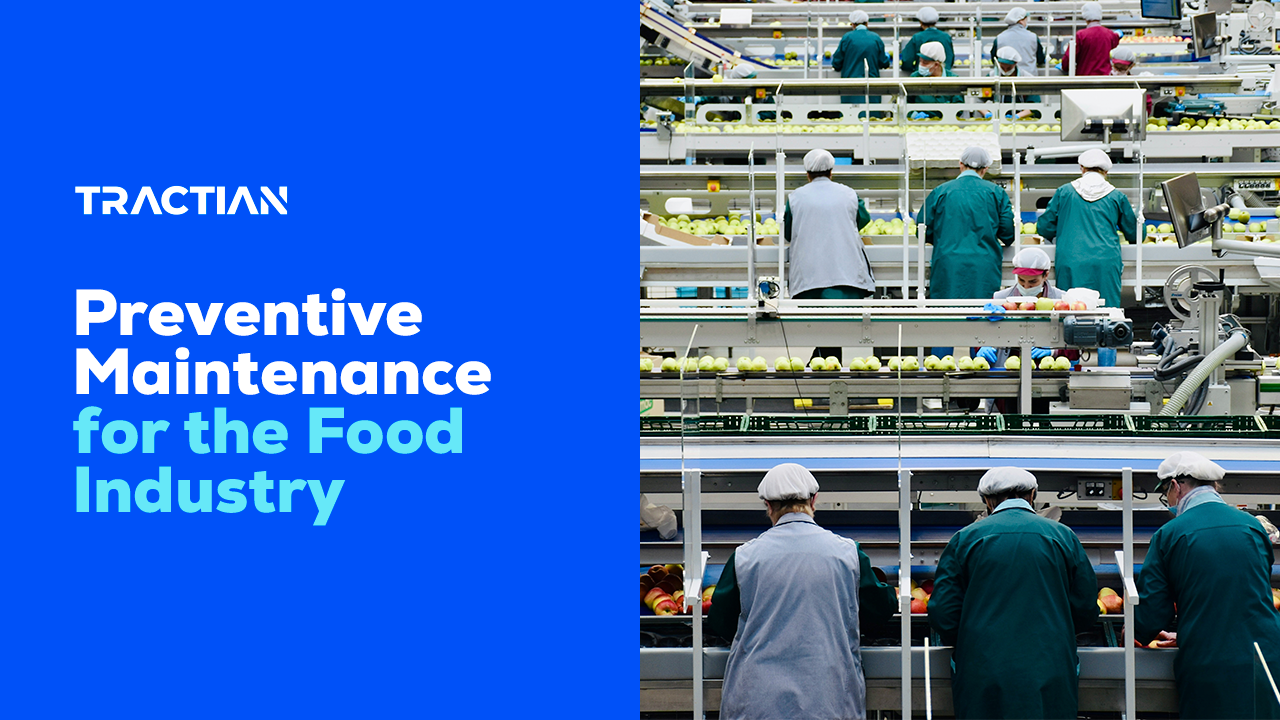Ever wondered why preventive maintenance in the food industry is so important? Sounds like a rhetorical question, we know. After all, it’s more than just a routine check-up, but a vital cog ensuring food safety, quality control, and smooth operational flow.
Don’t take it for granted: this is a dynamic industrial sector, where stakes are high, and margins are tight. So, preventive maintenance isn’t just an option-it’s an imperative.
It’s about preemptively addressing potential issues, maintaining the highest hygiene standards, and ensuring equipment runs at peak efficiency.
Here, TRACTIAN’s innovative solutions come into play, offering not just routine maintenance management but a strategic approach to asset performance and reliability.
Let’s dive into how preventive maintenance shapes the future of food production, and where TRACTIAN fits into this crucial narrative.
Understanding Preventive Maintenance in Food Safety
Imagine this: a crucial piece of machinery in your food production line sputters and dies. Not only is your production thrown into chaos, but the risk of contamination suddenly climbs through the roof.
That’s the harsh reality when preventive maintenance takes a backseat in the food industry.

Keeping your equipment running smoothly isn’t just about avoiding downtime.
It’s about protecting your customers and staying on the right side of strict food safety regulations. Think of it as building a wall of defense against contamination every time you clean, inspect, and service your equipment.
Think about it: food safety bodies like the FDA have rigorous standards for hygiene and equipment performance.
So, neglecting preventive maintenance is like playing a risky game with public health and hefty fines.
That’s where a proactive approach comes in.
A solid preventive maintenance in the food industry is like having a superhero on your team, constantly checking for weaknesses and preventing disasters before they happen.
Regular inspections, cleanings, and servicing become your routine, ensuring a safe production environment and products your customers can trust.
And to make things even smoother, tools like a CMMS come in handy.
They’re like digital assistants, keeping track of maintenance schedules, streamlining tasks, and making sure your food safety wall stays strong - all while keeping your operation running like a well-oiled machine.
Best Practices and Tips for Preventive Maintenance in Food Manufacturing
Forget just ticking boxes - in food manufacturing, preventive maintenance is the secret to operational excellence.
7 Practical Maintenance Strategies for Food Industries
But how do you whip up a truly effective program? Here are the key ingredients:
- 1. Regular Equipment Check-Ups: these routine inspections and tune-ups catch niggling issues before they turn into full-blown breakdowns. Keep an eye on wear and tear and make sure everything’s humming smoothly.
- 2. Hygiene Housekeeping: equipment and workspaces need to sparkle to keep contamination at bay. Regular cleaning schedules are your best friends, along with the right cleaning tools and techniques. Remember, spotless equals safety.
- 3. Staff Health Screenings: keeping your team healthy is crucial to protecting food safety. Regular health checks and questionnaires help identify potential risks early on, preventing any unwanted guests from sneaking into your products.
- 4. Spice Up Your Approach: why settle for plain old paper when you can add some flavor? Here are some innovative ways to boost your program:
- Checklist Champions: ditch the boring manuals and whip up checklists and infographics to make even the most complex maintenance schedules easy to digest.
- Tech-Savvy Training: train your team on hygiene and maintenance best practices using interactive modules and simulations.
- Real-Time Monitoring Solutions: tools like TRACTIAN’s equipment monitoring are like having a sixth sense for your machines. They give you real-time insights into their health, so you can switch from firefighting to proactive prevention.
By blending these practices into your daily routine, you’ll create a winning recipe for safety, quality, and efficiency - the holy trinity of the food manufacturing world.
Implementing a Preventive Maintenance Program: Steps and Strategies
Implementing an effective preventive maintenance program in the food industry involves several critical steps:
- Take Stock of Your Tools: first things first, give your equipment the once-over. This inventory list is your roadmap, showing you exactly what needs TLC.
- Weigh the Risks: not all machines are created equal, right? Figure out which ones play starring roles in production and food safety, and which ones are more like supporting actors. Knowing the potential impact of breakdowns is key.
- Schedule Some TLC: Now, let’s give those machines the pampering they deserve. Craft a schedule for regular maintenance, focusing on the high-risk and critical equipment first. Think oil changes, tune-ups etc.
- Train Your Team: Make sure they’re all maintenance experts with proper training on procedures and, of course, the all-important food safety regs.
- Cleanliness is Key: germs are uninvited guests we don’t want in our kitchens. Regular health checks for your team and strict hygiene practices in the workplace are crucial.
- Tech Time: Why don’t you embrace the future? A maintenance management software could be your new best friend, helping you track tasks, schedule like a pro, and stay compliant with all those food safety hoops.
TRACTIAN’s CMMS: Your Smart Ally
Speaking of tech, TRACTIAN’s CMMS is the solution to modernize your maintenance program.
It simplifies inventory, risk analysis, and scheduling, ensuring you’re always on top of things.
Plus, it helps you stay clean with built-in food safety compliance features.
So, why don’t you let TRACTIAN’s CMMS be your secret weapon for a safe, efficient, and top-notch food manufacturing operation?
Training and Hygiene: Cornerstones of Preventive Maintenance
In the food industry, training and hygiene are not just important-they are essential pillars of preventive maintenance.
Why?
Because a well-trained and hygiene-conscious workforce is your first line of defense against food contamination and costly production setbacks.
Picture this: A crucial piece of equipment malfunctions due to improper operation. Not only does production screech to a halt, but the risk of contamination skyrockets.
This scenario underscores the critical role of proper training in preventing equipment misuse and ensuring food safety.
Effective training goes beyond one-time workshops.
It’s about ongoing education, covering everything from equipment handling and maintenance protocols to strict adherence to hygiene standards.
Studies by the World Health Organization shows that “an estimated 600 million - almost 1 in 10 people in the world - fall ill after eating contaminated food and 420 000 die every year, resulting in the loss of 33 million healthy life years.”
But training alone isn’t enough. Maintaining a culture of hygiene is equally crucial.
This means implementing strict cleaning and sanitation procedures, regular hand washing protocols, and proper use of personal protective equipment (PPE).
The synergy between training and hygiene is powerful.
When every team member understands their role in upholding food safety and actively participates in maintaining the highest hygiene standards, the benefits are multifaceted:

Remember, food safety is a shared responsibility.
By equipping your team with the right knowledge and fostering a culture of hygiene, you can create a production environment where quality and safety reign supreme.
Technology Integration: IoT and Predictive Analytics in Maintenance
The integration of IoT and predictive analytics in preventive maintenance is transforming the food industry.
But how does this technology make a difference?
By harnessing IoT, food manufacturers can monitor equipment conditions in real-time, detecting issues like temperature fluctuations that could signal potential failures.
This data, when analyzed through AI and predictive analytics, becomes a powerful tool.
It not only predicts possible equipment malfunctions but also helps in optimizing maintenance schedules.
TRACTIAN’s technology stands at the forefront of this revolution.
By integrating IoT and AI, TRACTIAN’s solutions enable food manufacturers to predict equipment failures before they occur, thus preventing costly downtime and ensuring uninterrupted production.
This proactive approach to maintenance, backed by data-driven insights, ensures that food manufacturers are always a step ahead in maintaining safety and efficiency.
Use a PM Program for Food Production Plants
In food production plants, deploying TRACTIAN’s preventive maintenance (PM) program can be a game-changer.
How?
It starts with sophisticated devices like Vibration Sensor and Energy Sensor.
These devices provide real-time analysis of equipment conditions, flagging any signs of potential failures.
This data feeds into TRACTIAN’s CMMS, a robust maintenance management platform.
Here’s the impact: The CMMS facilitates efficient maintenance planning, tracks maintenance KPIs, and manages inventory.
With these tools, unexpected downtimes become a thing of the past, significantly boosting ROI.
TRACTIAN’s solution goes beyond mere maintenance - it’s about transforming machine operators into proactive maintainers with the combined power of IoT and AI.
Never heard of it? What about reading our article on AI-Assisted Maintenance?
This approach not only extends equipment life but also reduces preventive costs, with customers typically seeing payback in less than three months.
Such efficiency in maintenance directly translates to increased uptime and savings, making TRACTIAN’s PM solution a valuable asset for any food production plant.
Case Studies: Successful Preventive Maintenance in the Food Industry
Imagine a world where machines tell you their needs before they break down, allowing you to fix them before they disrupt production.
That’s the reality Corteva Agriscience - a multinational company that operates in three pillars: seeds, crop protection, and digital agriculture - unlocked with a proactive approach to preventive maintenance, powered by TRACTIAN’s technology.
Instead of scrambling after breakdowns, Corteva embraced intelligent sensors and TRACTIAN’s CMMS.
These watchful eyes kept a constant pulse on critical equipment, like vibrations hinting at potential trouble.
The result? A dramatic shift from reactive to proactive care.
Think about it: catching issues early meant less downtime, smoother production lines, and happier teams.
But the benefits went beyond mere convenience.
Corteva’s smart maintenance strategy translated to real cost savings, a testament to the power of predictive technology.
Corteva’s story isn’t just an anecdote; it’s a shining example of how TRACTIAN empowers businesses to transform their maintenance game.
Their case study (which you can read in full in our blog), along with others, paints a clear picture: predictive maintenance in the food industry is a must, something that boosts productivity and slashes unnecessary expenses.
So, the next time you hear the whirring of machinery, remember: within those sounds could lie the whispers of potential problems.
But with the right tools and a proactive approach, those whispers can be transformed into a lullaby of efficiency and cost-savings. Just like Corteva did.
Maintaining Compliance and Quality Standards
In the food industry, maintaining compliance with regulations and quality standards is crucial. That’s why PM plays a pivotal role in this.
But… How does TRACTIAN fit into this picture?
By using TRACTIAN’s solutions, food manufacturers can ensure their equipment adheres to the highest standards.
The real-time monitoring and predictive maintenance capabilities of TRACTIAN’s sensors and CMMS help identify potential issues before they escalate, ensuring equipment is always in top condition.
This proactive approach not only meets but often exceeds compliance requirements, guaranteeing the consistent quality of food products.
Conclusion
To adopt preventive maintenance in the food industry it’s a commitment to safety, quality, and operational efficiency.
It ensures that food production meets the highest standards while maintaining seamless operations.
And as we’ve explored, integrating TRACTIAN’s innovative solutions can significantly enhance these maintenance strategies.
Embracing TRACTIAN’s technology means stepping into a future where equipment failures are predicted and prevented, ensuring continuous production and upholding strict quality standards.
Consider TRACTIAN’s solutions as your partner in achieving these critical goals in the food industry.


